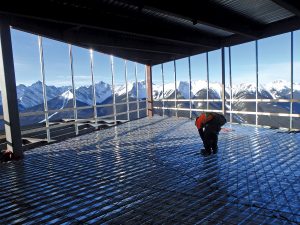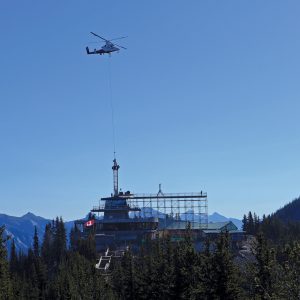
PCL’s upper terminal renovation elevates Banff’s top attraction
By Corinne Lynds
Concrete Construction Banff logistics PCLIt’s not everyday you get to enjoy a breath-taking view of the Rocky Mountains on your commute to work, let alone ride a gondola high above the treetops of Banff National Park. But, that’s exactly what PCL project manager Cole Kitchen and his crew did for an entire year.
In September 2015, PCL began a $26-million renovation of the Banff Gondola upper terminal building. Located at an elevation of 2,281 metres at the apex of Sulphur Mountain, this job came with more than a few logistical challenges.
The job
Although the project was considered a renovation, the main building was nearly demolished. “We took back [the entire original round building] to its concrete structure, and we had to install structural steel to compliment the existing concrete, and work off the original bones of the building,” explains Kitchen. The only structure that remained intact was the gondola hall itself, which is a green barn-like building that is now tied into the new structure.
With 90 workers on site at peak construction, the job took a year to complete. It was open to the public most of that time, and relied heavily on tools and training you don’t often see on a typical jobsite.
The logistics
With a lack of access to roads, and few alternative options, PCL relied on material carts secured to the gondola’s steel cables to carry up to 500 kg (1,100 lbs.) of construction materials per load.
“The gondola already had two material carts that they used for taking supplies and all sorts of materials that they need up to the terminal,” says Kitchen. “And so what they are is a 4 ft. by 5 ft. cart. Instead of having a gondola car fastened to the line, they have these material carts.”
PCL had four more carts made up, so there were a total of six available for transporting materials up and down the mountain. “We brought most of our materials up that way,” says Kitchen. “We could only transport materials up to 12-ft. long on a single cart. Anything that was longer than that, or heavier than 500 kg, we could take off two gondola carts and tie things directly to those in tandem. We ended up taking a lot of structural steel up that way. The longest piece was 53 ft.”
The contractors relied on the expertise of the gondola workers who made sure the carts were balanced properly. Counter-weights were used in just about every load to ensure the materials made it safely up the mountain. According to Kitchen no equipment or materials were ever tipped out of the carts during the eight-minute-trek.
The demolition of the existing structure meant a lot of materials needed to come down the mountain as well. More than 312 tons of concrete, 149 tons of steel, and 79 tons of debris were transported down the mountain through a complex schedule of gondola material carts and helicopter lifts.
The concrete and steel were 100 per cent recycled, and about 75 per cent of the debris was recycled too.
The helicopters
Four different helicopters with varying lifting capacities were used to do roughly 300 lifts throughout the course of the project.
The original design did not take into consideration the use of a crane for construction, owing to the remote location. “One of our most senior superintendents came up with the idea of using existing concrete to erect a Derrick crane on it,” explains Kitchen. “So we incorporated the new structural steel design, that Intuitive (the structural engineer) had designed, and we got them to modify it so it could actually carry this Derrick crane, and carry the loads.”
Once the structure was stripped back to the concrete, they broke a Derrik crane down into 35 separate pieces, and then used a helicopter to erect that crane over the course of two days in 35 trips.
The elements
The unique location of this project presented its own set of environmental challenges. Wind gusts up to 125 km/h, extreme temperatures, and wildlife were just a few of the considerations managed by the project team when working at such high altitudes.
“Weather was one of our bigger concerns for sure,” says Kitchen. “We dealt with a fair bit of snow, but the only thing that actually slowed us down was the wind. The crane would have to shutdown because of the wind.”
The safety training
Safety is a top priority on any jobsite, but even more so at the top of a mountain. The entire team supported a strong safety culture and were proactive in working collaboratively to ensure the safety of all members of the construction crew.
Particular attention was paid to flight patterns to address windy conditions. First-aid kits—designed specifically for the eventuality of a power failure caused by a mountain storm—were stocked with sleeping bags and food in case the weather prevented the workers from leaving the mountain. “We were lucky though,” says Kitchen. “No one ever got trapped up on the mountain overnight.”
In addition safety protocols were developed and coordinated with gondola staff to ensure all workers were transported safely to the base of the mountain at the end of each shift.
Kitchen explains: “We had a last man down the hill mentality. We would always do a headcount before closing up the site. We wanted to make sure we didn’t leave anybody there. That’s something you don’t normally have on a site in the city. It was a lot more remote and the guys worked really well together, and I think that’s why we had such a great safety record too. Everybody was really consciously looking out for each other.”
Workers on this project had to do some additional safety training for dealing with the local wild life, including bear safety.
“We had a dozen cans of bear spray on the site. And we worked hand in hand with Parks Canada. They were on-site on a bi-weekly basis wanting to know what animals were out. They wanted to make sure that nothing was being interfered with,” says Kitchen. “But they did tell us there were really no berries or anything on that mountain so the bears wouldn’t come up, but they could be down in the parking lot. So that was an interesting something I’ve never had to deal with on a jobsite before.”
The public
If the job itself wasn’t challenging enough, the client wanted to keep the mountain open as much as possible throughout construction without compromising the guest experience. For that reason the project required an aggressive timeline that included multiple partial occupancies of various areas within the building, including the gift shop, coffee shop, interpretive centre, and restaurant.
May 1st the gondola was opened so the public could go up and hike the trail surrounding the upper terminal. July 1st the first floor was opened up, and guests were able to visit the gift shop and café. In August floors 2 and 3 were opened up so guests had access to better food. Then September 15, the rooftop observatory on the 4th was opened.
“[These partial closed areas] made things challenging,” says Kitchen. “We would lose our laydown areas, and it got tighter and tighter and tighter.”
A helicopter was even used to bring in “fancy” public outhouses with running water and electricity at one point. The owner didn’t want the public to have to use regular construction outhouses while the main washrooms were out of commission.
The wrap-up
Despite the challenges, the state-of-the-art renovation to the upper terminal building went off without incident. The updates to the building include: an interactive family-friendly interpretive experience, a specialty cinema with theatre presentations, an expanded rooftop viewing deck, and all new food and beverage offerings.
As for Kitchen and his crew, they’re not commuting on a gondola anymore, but do feel fortunate for the time they spent with a bird’s eye view of the Rocky Mountains.
“Camaraderie among the workers was unusually high on this job,” says Kitchen. “And everybody that worked on it said, you know this is going to be a once in a lifetime project.”






